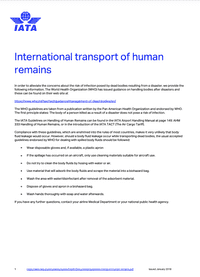International Transport of Human Remains
[International Transport of Human Remains]
To alleviate concerns about the risk of infection posed by human remains, IATA has provided this guidance on transporting dead bodies. They may be useful to staff involved in the transportation and clean-up of human remains following disaster situations.
SUMMARY
To alleviate concerns about the risk of infection posed by human remains, the International Air Transport Association (IATA) has provided International Transport of Human Remains guidance on transporting dead bodies. The guidelines are taken from the World Health Organization (WHO) and Pan American Health Organization (PAHO) publication "Management of Dead Bodies in Disaster Situations" and the IATA Airport Handling Manual. They may be useful to staff involved in the transportation and clean-up of human remains following disaster situations. The guidance details how to manage bodies to minimize exposure risks, and what to do in the event that body fluid leakage occurs in transport.
IATA, the trade association for world airlines, represents 82% of total air traffic. They are a world leader on aviation policy and work closely with the UN International Civil Aviation Organization (ICAO) to help set international shipping standards, as well as with the WHO. These guidelines were issued in January 2018, and are designed to work with national standards for transportation of human remains.


..png)
